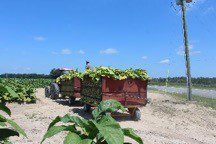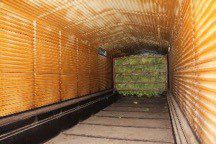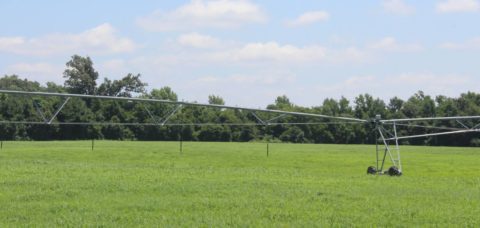 So far, this has been the driest season I’ve experienced in my 35 years of farming in this area of the U.S. Southeast. We finally received a good, soaking 5-cm, or 2-inch, rain during the first week of July. Prior to that, we hadn’t received rain for a couple months.
So far, this has been the driest season I’ve experienced in my 35 years of farming in this area of the U.S. Southeast. We finally received a good, soaking 5-cm, or 2-inch, rain during the first week of July. Prior to that, we hadn’t received rain for a couple months.
Since then, we’ve received another 12 to 13 cm, or about 5 inches, of rain in many of our fields.
That has made a huge difference in our soybeans, which are a resilient crop. The soybeans have taken advantage of the rain, growing well. By mid-July, they started flowering and setting pods. We are scouting them weekly to monitor for diseases and bugs, and we will only treat if needed.
Much like the soybeans, our sweet potatoes have taken advantage of recent moisture to grow. We scout them for disease and insect pressure, as well, treating only as needed.
However, the rain came too late for our corn crop. It tasseled and pollinated in intensely hot, dry conditions in late June and early July. It matured without moisture, and it is not doing well. This corn will be fully mature by early August, and we will likely start harvesting it in mid-August. I am choosing not to think too much about how poor the yields will be. At least the 20% of our corn crop under irrigation looks good.
The dry conditions had less impact on our animals. Our temperature-controlled barns keep both the turkeys and the pigs comfortable during the summer. Their feed, which includes soybean meal, keeps them growing.
 After more than three months on our farm, the turkeys we received on April 15 average about 18 kg, or 40 pounds. They have nearly reached market weight, and we expect Butterball, the company we raise the turkeys for, to start taking this group of turkeys for processing soon. I am incredibly thankful we have been able to keep this flock of about 504,000 turkeys healthy.
After more than three months on our farm, the turkeys we received on April 15 average about 18 kg, or 40 pounds. They have nearly reached market weight, and we expect Butterball, the company we raise the turkeys for, to start taking this group of turkeys for processing soon. I am incredibly thankful we have been able to keep this flock of about 504,000 turkeys healthy.
 By the end of June and beginning of July, our last group of pigs reached market weight and were sold. We cleaned our barns well, and in mid-July, we started receiving a new group of young pigs, weighing an average of 20 kg, or 45 pounds. By the last week of July, our barns will be full again.
By the end of June and beginning of July, our last group of pigs reached market weight and were sold. We cleaned our barns well, and in mid-July, we started receiving a new group of young pigs, weighing an average of 20 kg, or 45 pounds. By the last week of July, our barns will be full again.
In the fields next to our two sets of pig barns, we raise Bermuda grass for hay. Bermuda grass effectively converts the nitrogen and other nutrients from pig waste into forage. We sell that hay to area farmers as feed for cows. Various irrigation systems carry the leftover nutrients from the lagoons that store our pig manure to the hay fields. This approach to nutrient management is typical for eastern North Carolina.
Our attention has turned to harvest in our other crops.
We started harvesting cucumbers for pickles the third week of May. We raise seedless cucumbers and pick them by hand, so the plants continue producing cucumbers for weeks. Our crew goes over each field 7 to 12 times, so the total yield is about 2.25 metric tons per hectare, or 2,000 pounds per acre. Because of the heat this time of year, our crews start harvesting early each morning, as soon as it is light enough to see, and finish around noon. Between harvests in a field, we regularly scout and treat cucumbers for diseases that thrive in our hot, humid climate.

Tobacco harvest started on July 19, and it will continue through early October. We raise flue-cured tobacco. We harvest plant leaves as they mature. This is also done by hand. Our crew starts by harvesting just the bottom 4 or 5 leaves of each tobacco plant. As the plant matures, more leaves will be harvested. Leaf quality improves as they go higher on each plant. We go through each field 4 times, harvesting the mature leaves.

These leaves go into boxes hauled from the field to our curing barns. We cure the leaves for 7 days, forcing hot air up through the boxes. During that time, the air temperature increases from 32.2°C, or 90°F, to 73.9°C, or 165°F. We then compress the cured leaves into rectangular bales weighing about 360 kg, or 800 pounds.
Most of this work — as well as other tasks — is done by hand. Multiple crews work hard in our fields. Depending on what needs to be done each day, we have between 40 and 110 people working. Some of them have been with our farm for more than 20 years, and I consider them family.
The diversity of our crops and animals helps us spread risk to survive challenges, like the impact of dry weather on our corn. It also means that we are very busy — and we won’t slow down for months.
- These panels help control and monitor temperature, water and feed availability and other factors to keep animals comfortable inside barns regardless of the weather.
- Cucumbers are harvested by hand at about this size for pickling. Cucumber vines continue flowering and producing throughout the season, so each field is harvested multiple times.






